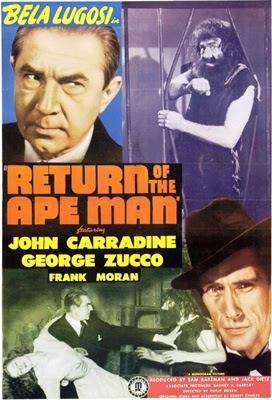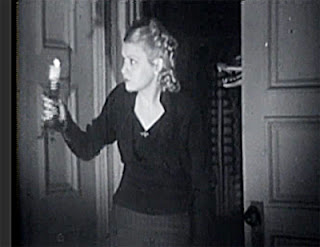While the archetypal mad doctor / scientist character is now seen as a quaint, amusing contrivance, it's no stretch to see why it was so prevalent in sci-fi and horror films of the 20th century. At the very same time that science was shrinking the world with new communications and transportation technologies, conquering diseases, and prolonging life, some of those same technologies were being used to wage world war and cause unimaginable pain, suffering and death. And in the 1950s, the ultimate application of science, the hydrogen bomb, threatened to end life and civilization as we know it. Is it any wonder that scientists in the movies were often portrayed as bat sh*t crazy?
 |
| "Now this isn't going to hurt... much...": John Carradine (wearing the lab coat) in The Invisible Man's Revenge (1944) |
In the 1940s alone, Carradine played doctors or scientists suffering from varying degrees of madness in 5 films:
- Captive Wild Woman (1943)
- Revenge of the Zombies (1943)
- The Invisible Man's Revenge (1944)
- Return of the Ape Man (1944)
- The Face of Marble (1946)
Lucky Netflix Instant Watch subscribers have a couple of Carradine's mad doctor flicks from the '40s at their disposal. While these are by no means great films and they scrape the bottom of the B production barrel (both are from Monogram Pictures, one of the lowly Poverty Row studios that hit its rickety stride in the '30s and '40s), the stories they tell are so off-the-wall and loopy that you might just be tempted to smile as they stream across your flatscreen.
Now Playing: Return of the Ape Man (1944)
Pros: Rare pairing of Carradine and Bela Lugosi; Harebrained Mad Scientist plots and dialog provide offbeat amusement
Con: Clumsily frenetic; Aimed at the lowest of common denominators
Pros: Rare pairing of Carradine and Bela Lugosi; Harebrained Mad Scientist plots and dialog provide offbeat amusement
Con: Clumsily frenetic; Aimed at the lowest of common denominators
In Brief: The movie opens with a newspaper headline about the ongoing mysterious disappearance of a notorious "tramp." Cut to a laboratory, where professors Dexter (Bela Lugosi) and Gilmore (John Carradine) are removing a body from an odd-looking glass-walled chamber. They lay him out on a table, inject him with something, and pretty soon the man is sitting up and rubbing his head, to the obvious delight of the scientists. The subject, obviously the tramp of the newspaper story, wonders how long he was unconscious. Dexter and Gilmore just smile knowingly. Dexter gives him some money and sends him on his way. We learn that he'd been kidnapped by the unethical scientists four months previously, and had been frozen in suspended animation all that time.
Dexter, apparently the head scientist and the more dominant of the two, isn't satisfied with just flash-freezing hobos and reviving them. He wants to revive someone who's been frozen in the ice for hundreds, if not thousands, of years. So Dexter, with Gilmore in tow, mounts an Arctic expedition to find a frozen cave man. After months with nothing to show for it, Gilmore is ready to give up, telling the obsessed Dexter that the chances of finding what they're after are one in an million. At that exact moment, an avalanche reveals -- you guessed it -- a cave man entombed in ice.
 |
| The "Ape Man" (Frank Moran) thinks about getting a haircut as the mad doctors decide what to do with him. |
Dexter is so keen to get on with his new project, that he selects his unwitting subject Steve (Tod Andrews) -- a law student and fiance of Gilmore's niece -- at a dinner party held at the Gilmore house. Gilmore notices Dexter's and Steve's absence just in time, and intercepts the professor before he can carve up Steve's brain. While Gilmore apparently had no qualms about kidnapping hobos and flash-freezing them, he draws the line at murdering people near and dear to him: "Science does not demand murder on its behalf!" he lectures the sullen Dexter, adding, "I believe you're quite mad!"
Undeterred, Dexter concocts a plan to trap an even better brain candidate. He succeeds in transplanting the brain mass into the "ape man," giving it the power of speech, but the brain augmentation does nothing to suppress the creature's killer instincts. The hairy humanoid goes on a rampage and leads Steve and the police on a mad chase through the city streets…
Mad Doctor Note #1: Return of the Ape Man sounds like a sequel, but it was simply Monogram's attempt to capitalize on one of their earlier Lugosi vehicles, The Ape Man (1943); while the characters and settings are different, they do share the common theme of mad science. Return gets pretty silly in the second half when Monogram's version of the Keystone Kops and Steve chase the "ape man" from the lab, to Gilmore's house, to a rundown theater (?!?), and back to the lab again. It does excel with ripe Mad Scientist dialog. One of the highlights is when Dexter sits off in a corner at Gilmore's dinner party, scowling at the other guests making small talk. "You know, some people's brains will never be missed!" he mutters.
Mad Doctor Note #2: Return of the Ape Man lists suave (and frequent B movie villain) George Zucco in the credits. According Richard Bojarski (The Complete Films of Bela Lugosi, Citadel, 1992), Frank Moran was supposed to play the pre-operation brutish cave man, and George Zucco was to play the more civilized, post-operative primitive man with an enhanced brain. Zucco pulled out before filming began with an unspecified illness (possibly after reading the script), and Frank ended up playing the part from beginning to end (the brain operation scarcely alters him). (Side note: the characters keep referring to Moran's character as an "ape man," and looking "more like ape than man." In actuality, Moran, dressed in tattered rags, looks only marginally hairier and rougher than the street bum that the good doctors experiment on at the beginning.)
Key Player: Like Carradine, Bela Lugosi kept popping up as a mad scientist throughout the mid-forties. In 1943's The Ape Man, he plays a scientist who turns himself into a half ape, half human hybrid, and spends the rest of the film desperately trying to find a cure. In Voodoo Man (1944), he plays an elegant doctor dabbling in voodoo to revive his beloved dead wife. And again, in 1945, he dons the mad doctor lab coat in the comedy-horror Zombies on Broadway. (Around that time he also took his turn playing the Frankenstein Monster in Frankenstein Meets the Wolf Man, 1943, and put on his Dracula cape for The Return of the Vampire, 1944.)
Now Playing: The Face of Marble (1946)
Pros: A step up in production values; Atmospheric with some interesting lab scenes
Con: Chaotic, confusing mix of sci-fi, horror and fantasy with a touch of voodoo; Convoluted love triangle (actually, quadrangle) taxes the viewer's patience
Pros: A step up in production values; Atmospheric with some interesting lab scenes
Con: Chaotic, confusing mix of sci-fi, horror and fantasy with a touch of voodoo; Convoluted love triangle (actually, quadrangle) taxes the viewer's patience
In brief: On a dark and stormy night, brilliant surgeon Charles Randolph (Carradine) hauls the body of a drowned sailor found washed up on the beach back to the laboratory at his seaside mansion. In a lucky coincidence, Randolph and his assistant, Dr. David Cochran (Robert Shayne) have been experimenting with an electro-chemical process to bring the recently deceased back to life, and the sailor is a perfect candidate. In a scene obviously influenced by the Universal Frankenstein movies, the sailor is revived amid impressive arcs of electricity. But there's a side effect: the man's face is unnaturally rigid and pallid-- "a face of marble!" Cochran exclaims. The sailor rises zombie-like, only to be laid low again by a near direct lightning strike on the house. Randolph returns the body to the beach, reasoning that since he was dead already, no harm was done.
Randolph's young socialite wife Elaine (Claudia Drake) is on to her husband, and pleads with Cochran to convince Randolph to give up the risky experiments. It turns out she married the older man in gratitude after he saved her life with a delicate brain operation, but the marriage has soured, and the ruggedly handsome Cochran is quite the temptation. Elaine's creepy but loyal servant Maria (Rosa Rey) spies on the two, sees the affection that her mistress has for the younger doctor, and makes up her mind to bring the two together using her voodoo arts (specifically by placing a voodoo love doll under Cochran's pillow to get him to fall for Elaine). When Cochran, confused and irritated, throws the doll into a beaker of acid, the mortified Maria predicts that violent death will come to the house.
Meanwhile, the local police inspector and old friend of Randolph's, Norton (Thomas E. Jackson), comes calling. It seems an autopsy of the sailor found that the body had undergone a severe electric shock, and the doc's the only person for miles around who's been experimenting with electricity. Randolph fends him off by appealing to their friendship, but Norton remains deeply suspicious.
Spooked by his old friend's questions, Randolph decides to go back to experimenting with animals, specifically, his wife's even-tempered and loyal Great Dane Brutus. He persuades the reluctant Cochran to help him one more time. Randolph kills poor Brutus, then tries to revive him. At first, it looks like the experiment has failed, but then, shortly after leaving the lab, the doctors hear him barking. Returning to the lab, they encounter a very aggressive dog baring its fangs. Randolph shoots it with no effect, then they watch flabbergasted as Brutus turns transparent and jumps through a closed window.
Having killed his wife's dog and turned it into a spectral Hound from Hell, Randolph continues to put the screws to the wayward Elaine (perhaps consciously, perhaps not) by inviting Cochran's girlfriend, Linda Sinclair (Maris Wrixon), to stay at the house. Elaine is clearly not pleased that she has to entertain her rival for David's affections as a houseguest. But soon, the attractive blonde girlfriend is itching to leave after being visited in her guest room by the the snarling Brutus who seems to be able to materialize out of thin air. At this point, the movie throws so many plot contrivances at the poor viewer, that you could forgive him/her for thinking that scenes from 3 or 4 different movies had been edited together by mistake. Local farm animals are drained of their blood, a devious murder plot is hatched, the would-be murderer makes a tragic miscalculation, people as well as animals start turning into ghostly spectres, an innocent character is framed, and the accused makes a quick, but implausible, break from police headquarters to save the day. It's as if the screenwriter had fallen behind on his deadline and started smoking wacky tobacky midway through the job. It's a wild '40s B ride, if you can hang on.
 |
| A dapper Robert Shayne from his Adventures of Superman days |
"After we had finished it, I went to see a preview of it over in South Los Angeles somewhere, with my wife and another couple. We were near the back of the house, and as this picture went along I hung my head, I was so embarrassed by it! Finally, when the thing was over, I got out into the lobby before anybody else did, and I was standing against a wall with my wife and this other couple. Two young ladies came out and stood against an opposite wall, and they did a double-take when they saw who I was. And one of them came over to me and said [wagging a finger], 'Mr. Shayne, you ought to be ashamed to be in a picture like that!'"Still, time heals many wounds. What might have seemed embarrassing back in the '40s becomes good, campy fun decades later.







